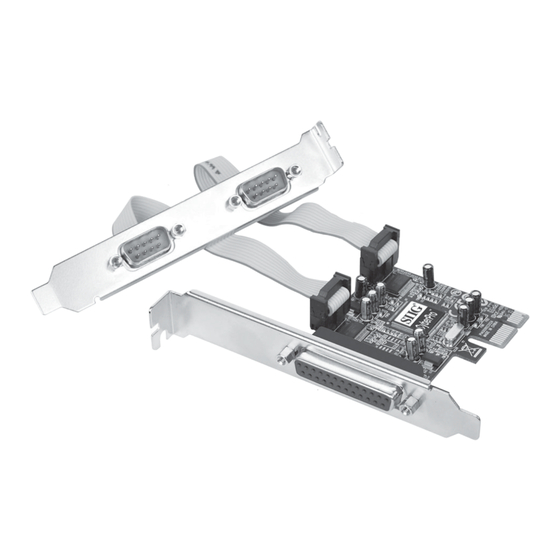
SIIG 2S1P Quick Installation Manual
Siig dvd vcr combo user manual
Hide thumbs
Also See for 2S1P:
- Quick installation manual (12 pages) ,
- Quick installation manual (12 pages)
Advertisement
Quick Links
Introducing the Cyber 2S1P PCIe
The Cyber 2S1P PCIe high-speed serial I/O card
provides two 9-pin serial ports and one parallel
port.
Key Features and Benefits
•
Adds 2 RS-232 9-pin serial ports and 1
ECP/EPP parallel port to your PCIe enabled
system
•
Compliant with PCI Express Base
Specification, Revision 1.1
•
Supports ECP, EPP and Buffered SPP
parallel port modes
System Requirements
•
PCI Express enabled system with an
available PCI Express slot
•
Windows
bit) / XP (32-/64-bit) / Server 2003 & 2008
(32-/64-bit)
04-0655A
Cyber 2S1P PCIe
Quick Installation Guide
7 (32-/64-bit) / Vista (32-/64-
®
1
Advertisement

Subscribe to Our Youtube Channel
Summary of Contents for SIIG 2S1P
- Page 1 Cyber 2S1P PCIe Quick Installation Guide Introducing the Cyber 2S1P PCIe The Cyber 2S1P PCIe high-speed serial I/O card provides two 9-pin serial ports and one parallel port. Key Features and Benefits • Adds 2 RS-232 9-pin serial ports and 1...
-
Page 2: Package Contents
Package Contents • Cyber 2S1P PCIe board • 2-Port DB9 serial port cable • Driver CD • Quick installation guide Layout 2-Port DB9 serial port cable Note: When connecting the 2-Port DB9 serial port cable, position the ribbon cable(s) so that the stripe is on the side closest to the parallel port. -
Page 3: Hardware Installation
Hardware Installation General instructions for installing the card are provided below. Since the design of computer cases and motherboards vary, refer to your computer’s reference manual for further information, if needed. Static Electricity Discharge may permanently damage your system. Discharge any static electricity build up in your body by touching your computer’s case for a few seconds. -
Page 4: Driver Installation
Skip this step if you don't need any serial ports. To install the card, carefully align the card's bus connector with the selected PCIe slot on the motherboard. Push the board down firmly, but gently, until it is well seated. Replace the slot bracket holding screw to secure the card. - Page 5 Insert the driver CD. Right click PCI Parallel Port, click Update Driver Software. Click Browse my computer for driver software. For 32-bit: Type D:\32bit, then click Next. (Change D: to match your CD-ROM drive) For 64-bit: Type D:\64bit, then click Next. (Change D: to match your CD-ROM drive) At Windows has successfully updated your driver software, click Close.
- Page 6 Click Don't search online. Skip this step and go directly to step 4 if not prompted. Click I don't have the driver disc. Show me other options. Click Browse my computer for driver software (advanced). For 32-bit: Type D:\32bit, then click Next. (Change D: to match your CD-ROM drive letter) For 64-bit: Type D:\64bit, then click Next.
- Page 7 Insert the driver CD, check Include this location in the search, uncheck the other box. For 32-bit: Type D:\32bit, then click Next. (Change D: to match your CD-ROM drive letter) For 64-bit: Type D:\64bit, then click Next. (Change D: to match your CD-ROM drive letter) Click Finish to complete the installation.
- Page 8 For 64-bit: Type D:\64bit, then click Next. (Change D: to match your CD-ROM drive letter) Click Finish to complete the installation. Windows Server 2008 (32-/64-bit) At Found New Hardware window, click Locate and install driver software (recommended). Click Don't search online. Skip this step and go directly to step 3 if not prompted.
- Page 9 To Verify Windows Installation Check in Device Manager to verify installation. For Windows 7: Right click Computer, click Manage, then click Device Manager. For Windows Vista: Right click Computer, click Manage, click Continue, then click Device Manager. For XP / Server 2003: Right click My Computer, click Manage, then click Device Manager.
- Page 10 From the Device Manager window double click Ports (COM & LPT), then double click PCIe to... port. Click Port Settings tab, then click Change Port Number. Click the down arrow next to the COM Port number box, select a COM port that is not in use.
-
Page 11: Technical Support And Warranty
Step 1: Submit your RMA request. Go to www.siig.com, click Support, then RMA to submit a request to SIIG RMA or fax a request to 510-657-5962. Your RMA request will be processed, if the product is determined to be defective, an RMA number will be issued. - Page 12 Fremont, CA 94538-3152, USA Phone: 510-657-8688 Cyber 2S1P PCIe is a trademark of SIIG, Inc. SIIG and the SIIG logo are registered trademarks of SIIG, Inc. Microsoft and Windows are registered trademarks of Microsoft Corporation. All other names used in this publication are for identification only and may be trademarks of their respective owners.










Need help?
Do you have a question about the 2S1P and is the answer not in the manual?
Questions and answers